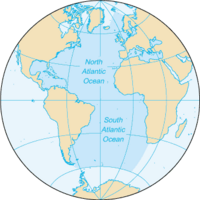
Photo from wikipedia
Abstract Starting in 2011, coastal areas of the Caribbean Sea and tropical Atlantic Ocean began to experience extraordinary yearly accumulations of pelagic Sargassum brown alga. Historical reports place large quantities… Click to show full abstract
Abstract Starting in 2011, coastal areas of the Caribbean Sea and tropical Atlantic Ocean began to experience extraordinary yearly accumulations of pelagic Sargassum brown alga. Historical reports place large quantities of Sargassum only in the North Atlantic (mostly in the Gulf of Mexico and the Sargasso Sea). Accumulations of Sargassum in the tropical Atlantic have continued. We used a numerical particle-tracking system, wind and current reanalysis data, drifting buoy trajectories, and satellite imagery to determine the origin of the Sargassum that is now found persistently in the tropical Atlantic. Our analyses suggest that during the extreme negative phase of the winter 2009–2010 North Atlantic Oscillation (NAO), unusually strong and southward-shifted westerly winds explain the transport of Sargassum from the Sargasso Sea (∼20–40°N, 80–20°W) into the far eastern North Atlantic. Our hindcast Sargassum distributions agree with surface current simulations with the inclusion of “windage”. Windage is the additional, wind-induced drift of material floating at the free surface resulting from direct wind forcing on the sea surface, as well as on floating or partially-submerged objects. In our simulations, windage is included as an added vector (speed and direction) to the model-computed surface ocean currents equivalent to 1% of surface wind velocities. Lagrangian analysis of the regional circulation suggests that (1) part of the Sargassum subsequently drifted to the southwest in the North Equatorial Current (NEC) and entered the central tropical Atlantic, arriving in the Caribbean by the spring of 2011, with (2) another portion continuing southward along the coast of Africa in the Canary Current, eventually joining the seasonally-varying system of tropical Atlantic currents and thereby delivering a large Sargassum population to the tropical Atlantic. Since then, Sargassum patches aggregate from March to September in massive windrows along the Inter-Tropical Convergence Zone (ITCZ) under the action of converging winds. The windrows follow the ITCZ in its seasonal northward migration in the central tropical Atlantic. They are stretched across the central tropical Atlantic as the ITCZ crosses the latitude of the seasonal formation of the North Equatorial Counter Current (NECC). These patches and windrows are exposed to high sunlight and open-ocean upward flux of nutrients due to eddy and wind-driven mixing in the central tropical Atlantic. During the northern spring and summer, as the Sargassum drifts farther north with the ITCZ, large portions of the population are advected into the eastern Caribbean Sea. Some of these patches remain dispersed as the ITCZ migrates southward, and re-aggregate into new windrows as the ITCZ intensifies the following March-April. If wind mixing is strong and the mixed layer is deeper than about 50–60 m in the southern tropical Atlantic at this time, the Sargassum will bloom and form a massive windrow. Otherwise, the bloom will be inhibited. The extreme 2009–2010 NAO wind anomaly could be considered as triggering a biosphere “tipping point” that caused important ocean-scale ecosystem changes in the tropical Atlantic, with significant recurrent social and economic consequences. Understanding whether this new expanded geographic range of massive Sargassum blooms is temporary or whether it will revert to its pre-2009 distribution requires sustained monitoring and research.
Journal Title: Progress in Oceanography
Year Published: 2020
Link to full text (if available)
Share on Social Media: Sign Up to like & get
recommendations!